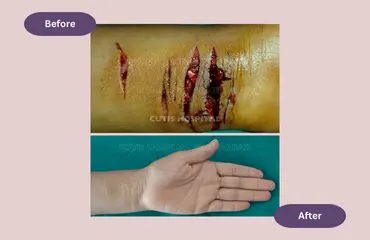Severely damaged nerves cause loss of muscle function and sensation. Nerve damage can occur due to spinal cord injury, facial paralysis, foot drop caused by peroneal nerve entrapment, and brachial plexus injuries. To repair and restore the functionality and mobility for leading a normal life, nerve repair surgery is performed by neurosurgeons. Hopistal stay for a few days is required, and recovery takes from a few weeks to months.
Nerve reconstruction involves transferring healthy nerves to the injured area for restoring sensation and function caused due to a nerve injury. If you are feeling numbness, or weakness in the muscle, reduced mobility, and nerve pain, this surgery is the ideal solution.
Patient Evaluation: Neurosurgeon meticulously examines the severity of the nerve damage, through clinical reports, assesses patient’s medical history and physical condition to determine the treatment plan.
Nerve Selection: Depending on the patient’s unique condition, the surgeon evaluates the surgery options: autografts, synthetic conduits, or allografts.
Surgical Team: A skilled team of surgeons, anesthesiologist, and nursing staff is assembled and briefed on the surgery and patient care.
Nerve repair surgery is a specialized branch of microsurgery medicine. It uses innovative research, techniques, and latest medical equipment to repair, regrow, and reconnect damaged nerves to improve their functionality and mobility, and help patients’ lead a normal life.
Nerve Grafting: It involves extracting a healthy nerve tissue (autograft) from another body part of the patient to bridge the gap in the damaged nerve. If the gaps are wider, nerve grafts from human donors (allografts) or synthetic nerves are used.
Nerve Transfer: It involves transferring healthy and functional nerve tissue to the area of the damaged site. This technique is effective for restoring function when damaged nerves cannot be directly repaired.
Nerve Regeneration: It involves using biomaterials to stimulate nerve regrowth.
Neuromuscular Re-education: Patients require physical therapy and rehabilitation to regain strength in their muscles and re-train their healed nerves to respond suitably.
Nerve repair surgery focuses on repairing damaged nerves to restore sensation and function to the area. Adequate post-surgery aftercare is required for complete healing and expected outcome.
Postoperative Care: It includes doctor’s instructions on pain management, wound care, and medication. It’s important to keep the surgical site clean and regularly monitor it for any signs of infection.
Immobilization: To protect the surgical site from infection and promote faster healing, the surgical site is immobilized with a cast, splint, or brace.
Physical Therapy: A physical therapist will guide patients through exercises that improve strength, mobility, and coordination of the reconstructed nerves and prevent muscle soreness.
Sensory Re-Education: It involves retraining the brain to interpret signals from the reconstructed nerves. Techniques like sensory stimulation and texture discrimination exercises are used for this purpose.
Pain Management: Nerve repair surgery may cause pain during the recovery phase. To manage it effectively, patients’ medical team prescribes medication and exercises.
Gradual Progression: Nerve regrowth is a slow process, spanning to several months and years. It's therefore important to be realistic on expectations and not rush the process. Patients must follow their surgeon and therapist advise on exercises and activities that will help through the recovery.
Nutrition and Hydration: A balanced diet rich in minerals, nutrients, and vitamins is important for nerve regeneration. Staying hydrated supports the healing progress.
Patience and Psychological Support: Nerve reconstruction recovery is mentally and physically challenging. Therefore, patients must attend support groups, talk to their family and friends, and if required seek mental health professional.
Follow-Up Appointments: To monitor recovery progress, patients must regularly visit their doctor’s office. They should ask questions on their recovery plan and make adjustments if needed for speedier recovery.
Depending on the severity of the pre-existing condition or injury, type of surgical method used, and rehabilitation therapy follow-up determines the result of the nerve repair surgery.
For instance, people opting for spasticity report improvements in arm position for washing and dressing, reduction in pain and tightness, and improvement in aesthetic appeal.
People with spinal cord injury report improvement in their seizing and releasing of cup or fork, enabling them to reach items on shelves, and extending their hand for a greeting.
We pride ourselves in superior surgery and care standards. Consequently, we constantly achieve higher patient satisfaction levels. We combine traditional and modern surgical techniques to provide tailored health solutions. Further, our board-certified team of doctors and medical care providers constantly invest in new scientific research to develop and provide enhanced patient care. In our holistic healing approach we focus on restoring and improving the nerve functionality while being mindful of the aesthetics.


Nerve reconstruction is required for injuries resulting from an accident, lacerations, or cuts. Also, medical conditions like tumors and nerve compression that impact nerve function.
Specialized surgeons like neurosurgeons and plastic surgeons who possess expertise in microsurgery techniques operate on patients.
Nerve grafting, nerve suturing, nerve conduits, and nerve transfers are the common surgical methods used to repair damaged nerves.
Depending on the severity of injury, surgical method used, and patient’s health, recovery process can take several weeks to several months. Rehabilitation with physical therapy is required for nerve regeneration and functional improvement.
Infection, scarring, nerve damage, and bleeding are the potential risks involved. However, advanced surgical methods have significantly reduced such risks.
Depending on the ability of the patient’s body to regenerate nerve tissue, surgical method used, and rehabilitation approach followed, some patients experience full recovery while other regain partial healing.
Cutis Hospital is conveniently located in Ghatlodia, Ahmedabad, making it easily accessible via multiple modes of transportation. Below are the various ways you can reach our facility:
Sardar Vallabhbhai Patel International Airport: Located approximately 12.7 km from Cutis Hospital, offering convenient access for patients traveling from outside the city.
Chandlodiya Railway Station: Approximately 2.4 km from Cutis Hospital.
Ahmedabad Railway Station: Around 11 km from our center.
GSRTC:
Ahmedabad Central Bus Station (GSRTC): About 10.3 km from the hospital.
AMTS:
Bhuyangdev Cross Road Bus Stop: Just 500 meters from Cutis Hospital.
BRTS:
Bhuyangdev BRTS Bus Stop: Only 170 meters from our center.
We provide effective surgical and non-surgical treatments for all parts of the body. At Cutis Hospital, our cosmetic and plastic surgery team is committed to giving patients safe and high-quality care.